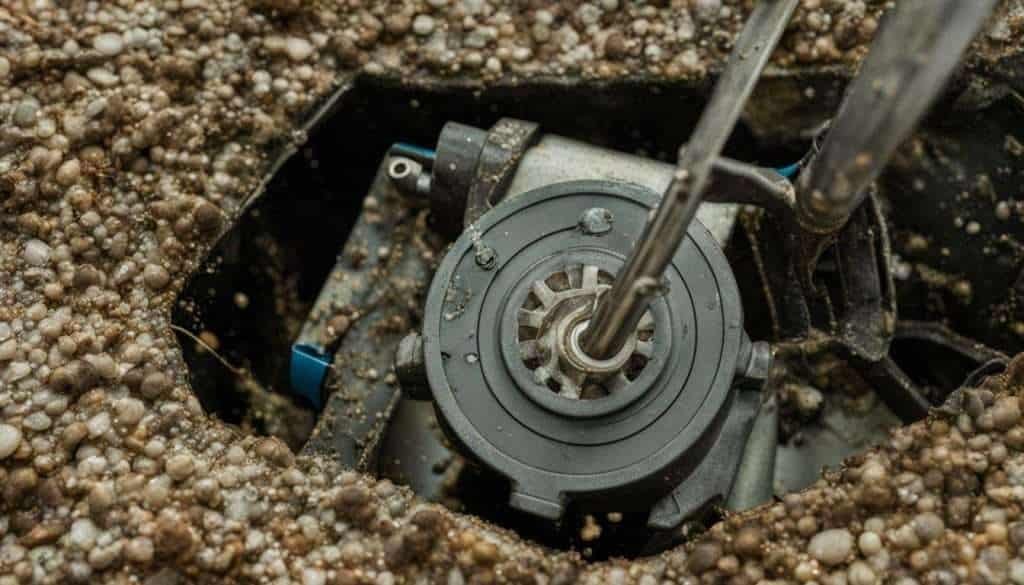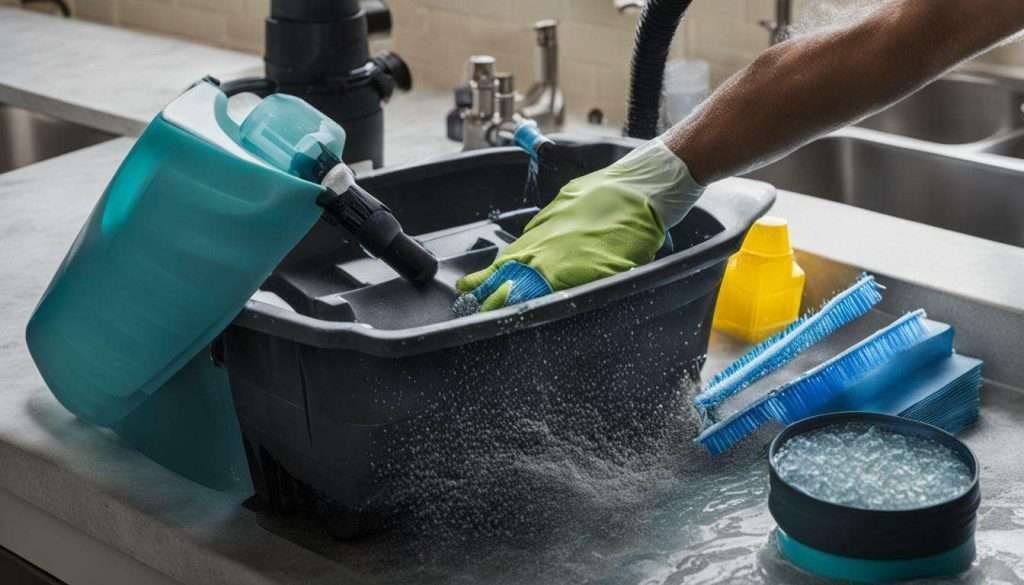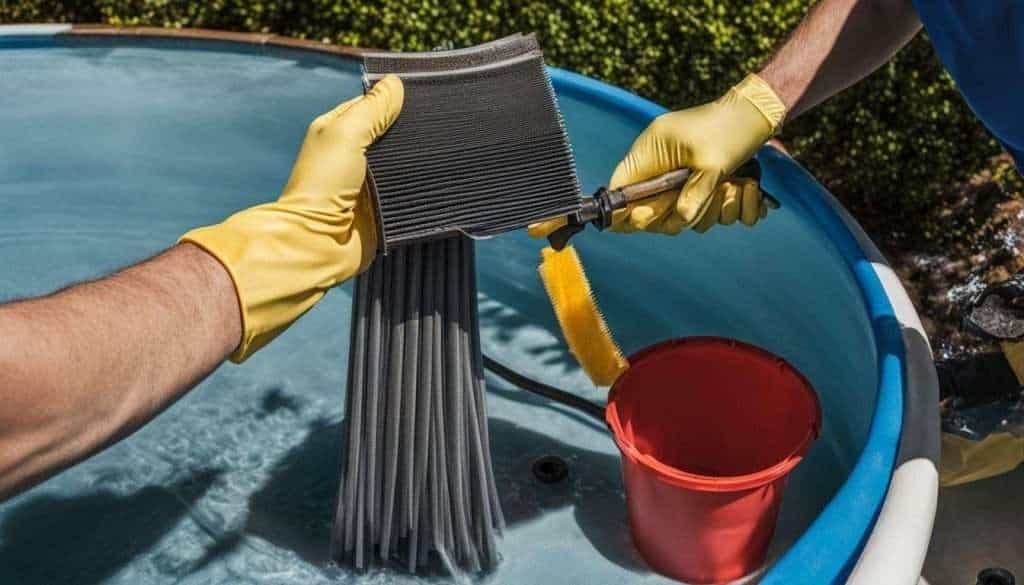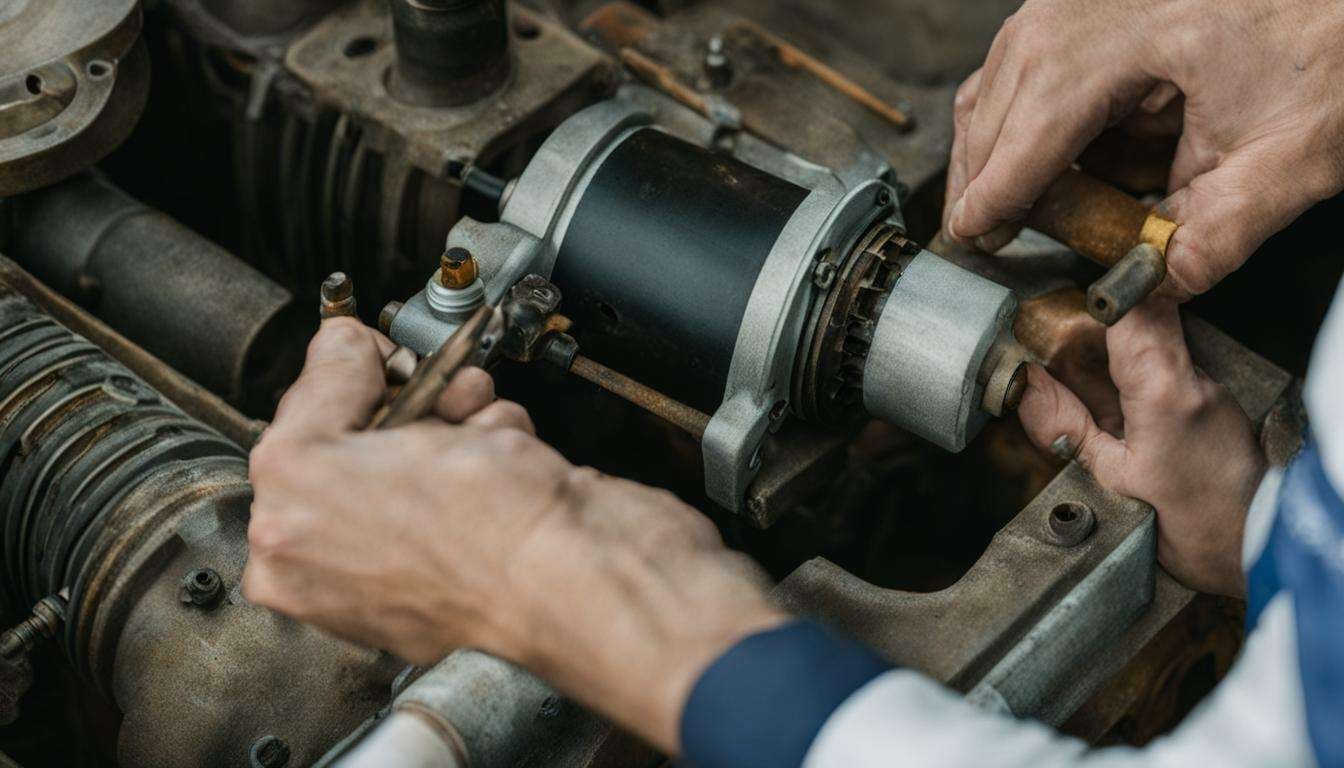Are you struggling with pool equipment problems and searching for effective solutions? Look no further. In this comprehensive guide, we will provide you with expert advice on fixing common pool equipment issues, ensuring your pool remains in optimal condition throughout South Africa.
Key Takeaways
- Regular maintenance is essential for preventing pool equipment problems and extending their lifespan.
- Pool pumps are crucial for maintaining water circulation and filtration.
- Common pool pump issues include air leaks, electrical problems, and reduced water flow.
- Diagnosing and repairing pool pump problems can save you money and ensure a properly functioning pool.
- Compare the cost of professional repairs versus DIY solutions before making a decision.
Understanding Common Pool Pump Problems
Pool pumps are essential for the proper functioning of your pool, but they can encounter various issues that affect their performance. In this section, we will explore the most common pool pump problems and guide you through troubleshooting and repairing techniques to keep your pool water circulating and clean.
One common problem pool owners face is air leaks in the pool pump system. This can lead to reduced water flow and decreased pump efficiency. To detect an air leak, you can perform a simple test by running the pump and inspecting the pump lid, seals, and plumbing connections for any signs of air bubbles or water leaks. If you find any issues, you can try tightening the pump lid, replacing worn-out seals, or resealing the plumbing connections using Teflon tape.
Another common issue is electrical problems, which can result in a pump failure or erratic performance. If your pool pump fails to start or experiences intermittent power issues, check the power supply, circuit breaker, and motor connections. Ensure that there are no loose or damaged wires and that the electrical components are in good condition. If necessary, consult a professional pool equipment repair service to handle electrical repairs safely.
Reduced water flow is another problem that can occur with pool pumps. This can be caused by clogged or dirty impeller blades, a blocked skimmer or pump basket, or a clogged filter. Regular cleaning and maintenance of these components can help prevent reduced flow and keep your pool water circulating effectively. Refer to your pool pump’s user manual for specific instructions on how to clean and maintain these parts.
| Common Pool Pump Problems | Troubleshooting Techniques |
|---|---|
| Air leaks | – Tighten the pump lid – Replace worn-out seals – Reseal plumbing connections |
| Electrical problems | – Check power supply – Inspect circuit breaker – Ensure proper motor connections |
| Reduced water flow | – Clean impeller blades – Clear skimmer and pump basket – Unclog the filter |
Quote:
If you find any issues, you can try tightening the pump lid, replacing worn-out seals, or resealing the plumbing connections using Teflon tape.
Now that you have a better understanding of common pool pump problems, you’ll be better equipped to troubleshoot and repair them. Remember, regular maintenance and having a professional pool equipment repair service on hand can help ensure that your pool pump operates optimally and extends its lifespan.

Troubleshooting Pool Cleaners
Pool cleaners are designed to simplify the task of keeping your pool free from debris, but they can encounter their own set of problems. In this section, we will explore common pool cleaner issues and provide you with troubleshooting techniques to ensure effective cleaning and maintenance of your pool.
One common problem pool owners face is blockages in the pool cleaner’s hose or filter. Debris and leaves can accumulate, obstructing the flow of water and reducing the cleaner’s effectiveness. To address this issue, start by checking and clearing any obstructions from the hose and filter. Use a hose or rod to gently dislodge the blockage, ensuring the cleaner’s path remains unrestricted.
Another issue that may arise is improper movement of the pool cleaner. If the cleaner is not moving smoothly across the pool’s surface or is getting stuck in certain areas, it could indicate a problem with the wheels or the cleaner’s drive system. Inspect the wheels for any signs of wear or damage, and replace as necessary. Additionally, check the drive belts or gears for any misalignment or malfunction. Adjust or replace these components to restore proper movement.

In some cases, the pool cleaner may not be functioning at all. This can be due to issues with the power supply or the cleaner’s motor. Check that the power source is connected and supplying electricity to the cleaner. If the cleaner still does not work, it may require a motor replacement or repair, which should be performed by a professional pool equipment repair technician.
By troubleshooting these common pool cleaner issues and taking appropriate measures, you can ensure that your pool cleaner remains in optimal condition, providing you with effective cleaning and maintenance of your pool.
Maintaining and Repairing Saltwater Chlorinators
Saltwater chlorinators are a popular choice for pool owners as they offer effective water sanitization without the need for traditional chlorine products. However, they require regular maintenance and can experience specific problems. In this section, we will guide you through the necessary steps to maintain and repair your saltwater chlorinator for optimal pool water quality.
To ensure the proper functioning of your saltwater chlorinator, regular maintenance is essential. Start by checking the salt levels in your pool to ensure they are within the recommended range. Low salt levels can lead to inadequate chlorine production, while high salt levels can cause corrosion and damage to the chlorinator. Use a salt test kit to measure the salt concentration and adjust as necessary.
Another crucial maintenance step is inspecting the cell plates in your chlorinator. Over time, calcium and other mineral deposits can accumulate on the plates, affecting their performance. Regularly clean the cell plates by soaking them in a solution of muriatic acid and water, following the manufacturer’s instructions. This will help maintain optimal chlorine production and extend the lifespan of the cell.
If you encounter any problems with your saltwater chlorinator, such as low chlorine output or error messages on the control panel, troubleshooting is necessary. Refer to the manufacturer’s manual for specific instructions on how to diagnose and resolve these issues. It’s important to address problems promptly to prevent further damage to the chlorinator and ensure the cleanliness of your pool water.

In conclusion, maintaining and repairing your saltwater chlorinator is crucial for maintaining optimal pool water quality. By following the recommended maintenance steps and promptly addressing any problems, you can ensure the longevity and efficiency of your chlorinator. Remember to consult the manufacturer’s manual for specific instructions and consider seeking professional assistance if needed. With proper maintenance, your saltwater chlorinator will continue to provide effective water sanitization for your pool, allowing you to enjoy a clean and refreshing swimming experience.
Troubleshooting Cartridge Filters and Pool Sand Filters
Cartridge filters and pool sand filters are integral components of your pool’s filtration system, ensuring that the water remains clean and clear. However, they can face various problems that affect their functionality. In this section, we will explore common issues with these filters and guide you through troubleshooting techniques to keep your pool water consistently filtered and free from impurities.
One common problem with cartridge filters is clogging. Over time, debris and particles can accumulate in the filter media, reducing its efficiency. To address this, regularly inspect and clean the cartridges by rinsing them with a hose or soaking them in a filter cleaner solution. Alternatively, if the cartridges are heavily soiled or damaged, consider replacing them with new ones for optimal filtration.
Another issue that may arise with pool sand filters is sand leakage or channeling. This can occur when the sand is improperly distributed or when the filter laterals become damaged. To resolve this problem, first, check the sand levels and ensure they are at the correct height. If the sand is too low or too high, it can lead to ineffective filtration. Additionally, inspect the filter laterals for any signs of damage or blockage and replace them if necessary.
Regular maintenance is key to preventing and resolving problems with cartridge filters and pool sand filters. Ensure that you clean and maintain these filters according to the manufacturer’s instructions to maximize their lifespan and maintain the water quality of your pool. By following these troubleshooting techniques, you can enjoy a well-functioning filtration system that keeps your pool water crystal clear.

Complete the table below to summarize the troubleshooting techniques for cartridge filters and pool sand filters:
| Problem | Troubleshooting Technique |
|---|---|
| Clogging | Regularly clean or replace cartridges |
| Sand leakage or channeling | Check and adjust sand levels, inspect and replace damaged filter laterals |
Pool Lights: Troubleshooting and Maintenance
Pool lights not only enhance the aesthetic appeal of your pool but also provide safety and visibility during nighttime swimming. However, they can encounter issues that affect their performance. In this section, we will explore common pool light problems and provide you with troubleshooting techniques and maintenance tips to keep your pool illuminated and inviting after dark.
Problem: Flickering Lights
If your pool lights are flickering, it could be due to a loose electrical connection. Start by ensuring that the light bulb is securely fitted in the socket. If the problem persists, check the wiring connections and tighten any loose screws or terminals. If the issue continues, it may be time to replace the bulb or consult a professional for further assistance.
Problem: Dimming Lights
Dimming lights can be caused by various factors, including a faulty transformer or a worn-out bulb. Begin by checking the transformer voltage to ensure it is supplying the correct amount of power. If the voltage is correct, try replacing the bulb with a new one. If the problem persists, it may be necessary to replace the transformer or seek professional help.
Problem: Complete Failure
If your pool lights are not turning on at all, start by checking the circuit breaker or fuse box to ensure that the power supply is intact. If the breaker has tripped or a fuse has blown, reset it or replace the fuse accordingly. If the issue persists, it could indicate a more significant electrical problem. In such cases, it is advisable to consult a qualified electrician to diagnose and resolve the issue safely.
Regular maintenance is essential to prolong the lifespan of your pool lights. Clean the light fixtures regularly to remove any dirt or debris that may obstruct the light output. Inspect the wiring connections and replace any damaged or corroded wires. Additionally, consider scheduling professional inspections to identify any potential issues before they escalate.

| Problem | Troubleshooting Techniques | Maintenance Tips |
|---|---|---|
| Flickering Lights | Check bulb and wiring connections | Regularly clean the light fixtures |
| Dimming Lights | Inspect transformer voltage and replace bulb | Inspect and replace worn-out wires |
| Complete Failure | Check circuit breaker or fuse box | Schedule professional inspections |
Conclusion
Congratulations! You have now gained valuable insights into fixing pool equipment problems and ensuring the proper functioning of your pool. By implementing the tips, techniques, and solutions provided in this guide, you can address common pool equipment issues and keep your pool in optimal condition throughout South Africa. Remember to prioritize regular maintenance and address problems promptly to extend the lifespan of your pool equipment.
Throughout this expert guide, we have discussed the importance of maintaining your pool equipment, focusing on the troubleshooting and repair of pool pumps, pool cleaners, saltwater chlorinators, cartridge filters, pool sand filters, and pool lights. We have explored common problems and provided practical solutions to help you maintain a pristine and operational pool. Moving forward, it’s important to remember that regular maintenance and troubleshooting common pool problems are key to ensuring the longevity of your pool equipment. By staying proactive and addressing issues as they arise, you can minimize downtime and costly repairs. Additionally, understanding the basic mechanics of your pool equipment can help you troubleshoot potential issues more effectively, ultimately saving you time and money in the long run. Furthermore, incorporating pool cover maintenance tips into your routine can greatly enhance the efficiency of your pool system. A well-maintained cover not only keeps debris out but also helps in regulating water temperature and reducing chemical usage. By investing a little time in these maintenance practices, you can ensure your pool remains in excellent condition year-round.
By regularly inspecting and maintaining your pool equipment, you can prevent issues such as air leaks, electrical problems, reduced flow, blockages, and malfunctioning components. This proactive approach will not only save you time and money but also ensure a safe and enjoyable swimming experience for you and your loved ones.
Lastly, we would like to emphasize the significance of pump warranties. When purchasing pool equipment, it is crucial to consider warranties that offer comprehensive coverage and peace of mind. Additionally, promptly addressing pool equipment problems will extend their lifespan, allowing you to enjoy your pool for years to come.
FAQ
What are some common pool pump problems?
Common pool pump problems include air leaks, electrical issues, and reduced water flow.
How can I diagnose pool pump problems?
To diagnose pool pump problems, you can check for air bubbles in the pump, test the electrical connections, and inspect the impeller for clogs.
How can I fix an air leak in my pool pump?
To fix an air leak in your pool pump, you can tighten the pump lid, replace the pump o-ring, or check and repair any damaged or loose connections.
What should I do if my pool pump has reduced water flow?
If your pool pump has reduced water flow, you can check for clogs in the impeller, clean or replace the filter, and ensure that the motor and impeller are functioning properly.
Should I attempt to repair my pool pump myself or hire a professional?
Whether to repair your pool pump yourself or hire a professional depends on your level of expertise and the complexity of the problem. In some cases, DIY repairs can save you money, but for more complex issues, it may be advisable to seek the assistance of a professional pool equipment repair service.
How often should I maintain my pool equipment?
It is recommended to regularly maintain your pool equipment, including pool pumps, cleaners, filters, and lights, to prevent problems and ensure optimal performance. A general guideline is to schedule maintenance every three to six months.
What are some common problems with pool cleaners?
Common problems with pool cleaners include blockages, improper movement, and malfunctioning components.
How can I troubleshoot and repair my pool cleaner?
To troubleshoot and repair your pool cleaner, you can check for blockages in the cleaner’s hoses or filter, clean or replace worn-out gears and cogs, and inspect and replace any malfunctioning components.
How can I maintain and repair my saltwater chlorinator?
To maintain and repair your saltwater chlorinator, you should regularly clean the chlorinator cell, check and adjust the salt levels, inspect and clean the electrodes, and replace any worn-out or damaged components.
What are some common problems with cartridge filters and pool sand filters?
Common problems with cartridge filters and pool sand filters include clogging, leaks, and reduced filtration efficiency.
How can I troubleshoot and resolve issues with cartridge filters and pool sand filters?
To troubleshoot and resolve issues with cartridge filters and pool sand filters, you can clean or replace the filter cartridge, inspect and repair any leaks or damaged components, and ensure proper backwashing and maintenance of the sand filter.
How can I troubleshoot and maintain my pool lights?
To troubleshoot and maintain your pool lights, you can check the bulbs for any burnouts, inspect the wiring for loose connections, and regularly clean and replace the fixtures as needed.


